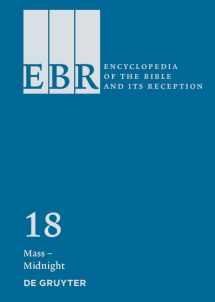
Mass – Mime
Book details
Summary
Description
The projected thirty-volume Encyclopedia of the Bible and Its Reception (EBR) is intended to serve as a comprehensive guide to the current state of knowledge on the background, origins, and development of the canonical texts of the Bible as they were accepted in Judaism and Christianity. Unprecedented in breadth and scope, this encyclopedia also documents the history of the Bible''s interpretation and reception across the centuries, not only in Judaism and Christianity, but also in literature, visual art, music, film, and dance, as well as in Islam and other religious traditions and new religious movements.
The EBR is also available online.
Blogger''s Choice - Articles recommended by biblioblogger Jim West (https://zwingliusredivivus.wordpress.com)
Sidnie White Crawford (East Stroudsburg, Pa., USA), Matriarch, Matriarchs IV. Judaism A. Second Temple and Hellenistic JudaismCrawford begins her subsection thusly: "In Second Temple Jewish literature, the matriarchs of Israel - Sarah and Hagar, Rebekah, and Leah, Rachel, Zilpah, and Bilhah - appear alongside their male counterparts Abraham, Isaac, and Jacob in retellings of Genesis, in parabiblical literature based on Genesis, and in testamentary literature. For the most part, the matriarchs simply reprise their roles in Genesis as wives and mothers, although occasionally new information about one or the other designed to fill in gaps in the Genesis narrative (especially in genealogy) appears." The information in the remainder of the entry is helpful as well as thorough.
Johannes Unsok Ro (Tokyo, Japan), Mebunnai
This very brief (one paragraph) entry notes the textual uncertainty of this character and points readers in the direction of a possible solution. The thoroughness of EBR is once again on display as this entry illustrates the fact that no corner of the biblical text is too obscure to be overlooked and ignored.
Anthony Swindell (Llanidloes, United Kingdom), Mediator V. Literature
One of the more extensive entries is ''Mediator.'' Written by a range of scholars, and covering many aspects of the word''s usage both in and out of Scripture, one of the more interesting sections is its treatment in literature. Anthony Swindell writes in part, "Angels as mediators receive extensive treatment in literature, particularly after the prominence given to Michael in the Song of Roland (12th cent.). The angel Raphael becomes in literature a sort of living extra-biblical extension of the Book of Tobit in texts extending from works connected with the medieval Guild of St. Raphael to Sally Vickers'' novel, Miss Garnet''s Angel (2000)." The entire entry is very much worth examining.
André Lemaire (Paris, France), Mediterranean Sea I. Ancient Near East and Hebrew Bible/Old Testament
Lemaire''s work describes the Mediterranean as it is mentioned in the Hebrew Bible. Noting first its geographical features, he rightly then observes, "The first chapter of the book of Jonah seems to be characteristic of the general feeling of the ancient Israelites towards the "Great Sea." This is an interesting contribution and it has ample examples from Scripture to illustrate the points Lemaire makes.
Eve-Marie Becker (Münster, Germany), Meek, Meekness II. New Testament
"The Greek term for ''meek/meekness'' is πραΰς κτλ." Becker writes. Following this, she analyzes the term quite thoroughly, astutely observing "In 1 Cor 4:21 and Gal 5:23, Paul defines πραΰτης in close affinity to ἀγάπη and πνεῦμα, and thus reveals its meaning in light of the community''s Christ-believing identity." She demonstrates, in sum, that the early Church may have had a vocabulary in common with the wider world, but it also put its own stamp on many words (my words, not hers).
Matthieu Richelle (Vaux-sur-Seine, France), Melech
At the conclusion of this brief entry we read "According to Brettler, the name Melech hints at a dynastic hope among descendants of Saul. This hypothesis is related to a (disputed) onomastic analysis according to which the element ''melech'' in some Hebrew names refers to a human king (e.g., Abimelech would mean ''My father is king'' not ''The [divine] Father is king'')." What precedes, though brief, is intriguing.
Richard R. Viladesau (Seaford, N.Y., USA), Messiah VIII. Visual Arts
Noting "By the time visual art became common in Christianity, the title ''Messiah'' (Christ) had effectively become part of Jesus'' name, while his function as the promised king of Israel was subsumed into the Johannine notion of the divine Logos made flesh, a universal savior and redeemer. In early Christian art, the symbols of his exalted status were largely taken from the Greco-Roman iconography of the gods and of the emperor: a purple or gold toga and/or claves. He is sometimes enthroned above the cosmos," Viladesau looks deeply into the many ways in which the Messiah has been portrayed in art. A very interesting painting of the figure of the Messiah is found in the entry. Artwork is an important resource included in the Encyclopedia and such resources are immensely helpful for illustrative purposes for students and classes.


We would LOVE it if you could help us and other readers by reviewing the book
Book review



